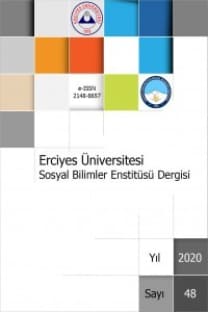Kayseri’nin İlk Modern Eğitim Yapısı: Kayseri Lisesi
Araştırmaya konu olan Kayseri’nin ilk modern eğitim yapısı; Kayseri Lisesi, Kayseri ili Melikgazi ilçesi, Kiçikapı Mahallesi’nde Ermeni Kilisesi’nin doğusunda yer almaktadır. Yapımına 1884 yılında başlanan lisenin 1903-4 yıllarında zemin, 1916 yılında 1. Katı tamamlanmıştır. 1927 yılında ise bu mekanların yetersiz olmasından dolayı yapıya ek binalar ilave edilmiştir. Genel olarak muntazam kesme taştan inşa edilen ve kırma çatı ile örtülen yapının Kuzey Güney cepheleri Doğu Batı cepheleri ile simetrik olarak tasarlanmıştır. Yine binanın alt kat pencereleri ile üst kat pencereleri de aynı düzende oluşturulması ile önemlidir. Bu cepheler silme kuşakları, kabaralar, ve pencerelerle hareketlendirilmiştir. Yapının iç mekanı bodrum, zemin ve birinci kattan oluşmaktadır. Lisenin zemin ile birinci katı genel olarak birbirleri ile aynı planda ve simetrik olarak tasarlanmıştır. Eser U şeklinde bir giriş kısmına sahiptir. U şeklindeki koridora açılan karşılıklı odalar bulunmaktadır. Bu odalar zemin katta toplamda 13, birinci katta 12 adettir. Odalar dönem üslubuna uygun yuvarlak kemerle son bulan büyük ebatlı pencereler ile aydınlatılmaktadır. Lisenin dış cephesinde siyah yonu Germir taşı ve çift taraflı yonu taşı kullanılırken; iç mekanda mancusun taşı ve ahşap malzemeler çimento, mozaik harçlarla birlikte kullanılmıştır. Yapının inşasında kullanılan orijinal malzemelerle ilgili Başbakanlık Osmanlı Arşivi’nden elde edilen belge mevcuttur. Kayseri’nin ilk modern eğitim yapısı niteliği taşıyan Kayseri Lisesi binası; gerek şehirdeki konumu, gerek şehirdeki diğer yapılara oranla abidevi görüntüsü, gerekse de mimari özellikleri ile dikkatle korunması ve bir an önce onarılması gereken bir taşınmaz kültür varlığıdır
Anahtar Kelimeler:
Sanat Tarihi, Kayseri Lisesi, Mimari, Bina
THE EARLIEST MODERN EDUCATIONAL BUILDING IN KAYSERI
Kayseri Lisesi, the earliest modern building of education in Kayseri, is located at the east of Armenian Church at Kiçikapı District in Melikgazi of Kayseri. The construction of the building began in 1884, and the ground of it was completed in 1903-4, and the first floor was built in 1916. Some auxiliary buildings were added in 1927 due to certain inadequacy of these places. The building has been generally built with cut stone and covered with hipped roof. The northern and southern facades have been symmetrically arranged with those at east and west. Likewise, the lower windows have been organized in the same manner with those at the upper level. These facades have been enlivened with molding bands, kabaras (hobnails) and windows. The inner place of the building consists of the basement, the ground and the first floor. The ground and the first floor of the high school building have been symmetrically designed in the same outline. A U-shaped entrance draws attention in the building. There are corresponding rooms opening to the U-shaped corridor. The thirteen of those are at the ground level and the other twelve are at the first floor. The rooms have been lightened through the high windows ending with round arches, which seem to be the fashion in the age. While the black cut stone, namely Germir, and double-sided cut stone have been used in the outer space of the buildings, such materials as Mancusun stone and other wooden things have been used along with cement and mosaic mortar. Some official documents obtained from Ottoman Archives of Prime Ministry are available on the original materials used in the construction process of the building. The building of Kayseri Lisesi is an unmovable cultural asset deserving elaborate conservation and urgent restoration with the location in the town, the monumental view of it against the other surrounding buildings and its architectural characteristics.
Keywords:
Art History, Kayseri Lisesi, Architecture, Building,
- Yayın Aralığı: Yılda 2 Sayı
- Yayıncı: Erciyes Üniversitesi
Sayıdaki Diğer Makaleler
Kayseri’nin İlk Modern Eğitim Yapısı: Kayseri Lisesi
Firavun Zulmüne Karşı Bireysel İnisiyatif
Korece Sözcüklerin Anlam İlişkileri Yönünden Türkçe Sözcüklerle Karşılaştırmalı Analizi
The Image of Earlier and Contemporary Poets in Persian Divan of Shahriar
Kayseri Ve Bursa Milletvekili Bahri Yazır’ın Meclis Çalışmaları
Açık Hava Reklamları: Kentsel Kimlik Mi Kentsel Kirlilik Mi?
Müşteri İlişkileri Yönetimi Ve Perakende Sektörüne Yönelik Bir Uygulama
